Musicarta Twelve-bar Piano Styles
Moving Pair - Module Two
This module is in two parts.
- Learning the best fingering for the Moving Pair riff, and
- Learning the twelve-bar chord sequence to help you jump to the right notes when the chord changes.
Module Two continues teaching the Moving Pair riff.
Fingering the Moving Pair riff
Good fingering makes playing great music possible, and bad or simply random fingering will trip you up every time until you fix it. So best get used to fingering that works from the start!
Probably the best fingering to use for the Moving Pair riff is this:
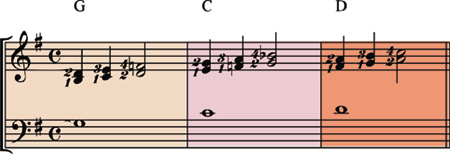



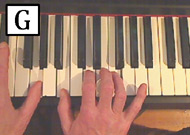 |
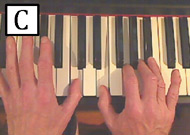 |
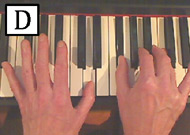 |
The photos show the lowest, and first, pair for each chord – the notes you jump to when you change chords.
Notice that the right hand thumb has to play two notes in each position.
The placing of the fingering numbers on the keyboard is realistic – it indicates that you have to play the white keys in the C and D positions right up between the black keys (as you can see also in the photos underneath).
Keyboard learners often think it’s wrong to play white keys up between the black keys like this, but as you can see from the photos, you absolutely have to. It might feel a little awkward at first, but you’ll get used to it. And please note that it’s very, very rare for a person’s fingers to truly be too big to play the keys this way – it just feels like that at first!
Practice the Moving Pair pattern in all three positions using this fingering. Only you will know if you’re using the right fingering, so be observant and strict with yourself.
The twelve-bar chord sequence
The music examples you’ve seen so far – like the one below – are all four bars’ worth of music. Here is the written-out music for the first G position part of the twelve-bar chorus.

That is four bars of music. One bar of music is this:
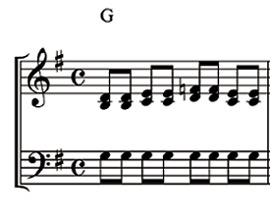
‘One bar’ is eight chords, counted “One and two and three and four and”
You need to know this because you are going to read the following chord sequence, where each chord symbol indicates one bar of the pattern – and which chord it is.

The chord chart shows one chorus of the classic twelve-bar chord sequence. The audio counts you through two twelve-bar choruses.
The twelve-bar as three sets of four bars
It’s easiest to read the chord sequence as three lines of four bars each.
- For the first four bars (the first line of the table), your left hand stays on note G (the root), and you play the pattern in G four times.
- Then you play two bars of C and back for two bars of G (second line of the table)
- To finish, you play one bar (pattern) in D, one in C, and back for two bars in G.
You’ve played the one-bar pattern 12 times, built on the note named in the chord symbol.
Here are the chords laid out in a string:
Read the chord sequences – both the table and the laid-out string – as you listen to the Moving Pair riff performance again, until you can see how the music and the chord sequence match up.
You should be able to point out which bar in the chord sequence you’re listening to.
The chord ‘structure’
The chord symbols on there own don’t really make the structure of the chord sequence stand out. Here’s the chord sequence with the bars colour-coded according to the chord:

The colours show up the structure well, and the structure makes the chords in a twelve-bar a lot easier to remember.
Here are the twelve bars in a line, also colour-coded.
This is the basic twelve-bar chord sequence.
- Four bars of the first chord (G, in this case) – the ‘key’ chord. (We’re ‘in G’.)
- Two bars of the next chord (C – also the next chord up, too), then back for two bars of the first chord (G).
- One bar of the highest chord (D), one bar of the next chord down (C), and two bars of the first chord (G).
There are many variations on this basic twelve-bar sequence, but you need to know this basic chord order by heart.
Listen to the Moving Pair riff again while reading the chord sequence until you understand how the chord sequence ‘describes’ the music, and your eyes move through the chord sequence at about the same speed as the music does. You should be able to anticipate the chord changes.
Module summary
Module Two is asking that you do these two things at once:
- Play through the chord sequence at a reasonable practice speed using the ‘official’ fingering, and
- Know where you are in the twelve-bar chord sequence (to help you navigate the jumps).
Obviously, accomplishing this is a medium- to long-term aim! There is a Troubleshooting module up next to help you tackle the difficulties efficiently.
Here's the module tutorial/'walk-through'. Be sure to study the notes as well, though!
|
OUT NOW! |
THE MUSICARTA BEAT & RHYTHM WORKBOOK At last! An effective approach to keyboard rhythm & syncopation skills. Learn more! |
ONLY $24.95! |
TWELVE-BAR |
The MusicartaA methodical approach to keyboard syncopation for
|
PUBLICATIONS
exciting keyboard
creativity courses
CHORDS 101
WORKBOOK

~HANON~
video course

Musicarta
Patreon
PENTATONICS
WORKBOOK
video course

Creative Keyboard
video course

BEAT AND RHYTHM
WORKBOOK

- Volume 1 -

12-BAR PIANO
STYLES WORKBOOK

MUSICARTA MODES
WORKBOOK

PIANO STYLE

CANON PROJECT
video course

VARIATIONS
video course


- Piano Solo -
video course

- Piano Solo -


YouTube playlists





 THE LOGO
THE LOGO
